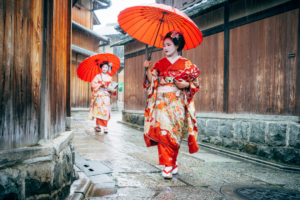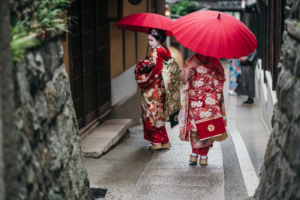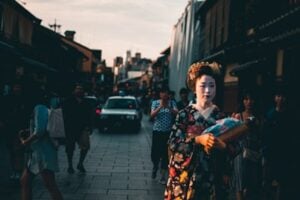

Have you ever wanted to know the history of maiko?
Many people are fascinated by its glamorous and beautiful appearance, but not much is known about its actual history and culture.
This article details the evolution of maiko from its origins to the present day, and also introduces stores where you can actually experience maiko.
This article will answer any questions you may have about maiko and help you rediscover the depth and charm of Japanese culture.
Feel more familiar with the world of maiko and enjoy its charms to the fullest.
What is Maiko?

Before looking at the history of maiko, let us first learn more about what a maiko is.
A maiko is a young woman in training to become a geiko in the future, active in Kyoto’s Hanamachi district.
These women are characterized by wearing gorgeous kimonos, fastening distinctive sarari obis, carrying ozashiki baskets, and wearing footwear called okobo.
Maiko perform dance and music while preserving traditional Japanese culture.
Specific roles and activities of maiko
- Dance performance
- Serving customers in a tatami room
- Cultural Transmission
- Contribution to the tourism industry
Training to become a maiko begins after graduation from junior high school.
The first year is spent living in an Okiya as a “shikkuri” (training).
During this period, students learn to help with household chores, manners, the Kyoto dialect, and dance.
Then, as an “apprentice” for about one month, the apprentice practices in the ozashiki room with the sister geiko and makes her debut as a maiko, known as “mise-dashi.
In the past, a maiko could become a maiko at the age of 10 or 13, but today it is common for a maiko to begin her training after graduating from junior high school.
Difference between MAIKO and GEIKO

Have you ever heard the name geiko in addition to maiko? Both are representatives of traditional Japanese culture, but there are some differences in their roles and characteristics.
Let’s take a closer look at the differences between maiko and geiko.
| apprentice geisha | geisha | |
| Age and Experience | Young women around 20 years old after graduating from junior high school. An apprenticeship to become a geiko. |
Women after the age of 20 who have completed training as a maiko. He has extensive experience and skills. |
| Costume and Appearance | Gorgeous Kimono Long slender belt Japanese hair tied with your own hair Gorgeous hair ornament Thick-soled footwear called “Okobo |
Kimonos in calm colors Short belt Wigs Simple hair ornaments Footwear is zori. |
| Roles and Tasks | They perform dances and songs to the main guests and add color to the tatami room. The production and light conversation with the guests will liven things up. |
He reads the entire flow of the tatami room and acts as a facilitator. She is proficient in dancing, singing, shamisen playing, tea ceremony, and general hospitality. |
| The process of training |
After graduating from junior high school, he lived in an Okiya, |
After completing the training of a maiko, she goes through a ceremony called “collar change. Officially started activities. The red collar of a maiko changes to the white collar of a geiko. |
Both maiko and geiko carry on traditional Japanese culture by fulfilling their respective roles.
History of Maiko from ancient times

Learn more about the historical background of maiko.
Beginning with bugaku and female performers in ancient Japan, the program will delve into the development of court culture and maiko in the Heian period (794-1192).
Let’s look at the origins and evolution of maiko and how they are strongly related to bugaku, court culture, and court culture, and how maiko have taken root in traditional Japanese culture.
Bugaku and Female Performers in Ancient Japan
Bugaku is a traditional Japanese court dance, an art form with a history of over 1,400 years.
It was introduced from China and Korea during the Nara period (710-794) and became widely popular among the aristocracy during the Heian period (794-1185).
The origins of bugaku can be traced back to ceremonial dance and music from China and the Korean peninsula.
Under these influences, the Japanese original elements were added and developed.
Especially during the Heian period (794-1185), dances and music were frequently performed at court as entertainment for the nobility and as part of religious ceremonies.
In ancient Japan, female performers also played an important role in bugaku and other ceremonial arts.
In religious ceremonies such as Kagura (kagura), women were in charge of dancing and singing as an offering to the gods.
This became the basis for the later culture of maiko and geiko.
Court Culture and the Development of Maiko in the Heian Period
During the Heian period (794-1185), court culture flourished more than at any other time in Japanese history.
During this period, the performing arts, which were precursors to bugaku and maiko, developed greatly.
The Heian period (794-1192) was a time of flourishing culture and art, and historical figures such as Fujiwara no Michinaga and Murasaki Shikibu were active.
Literary works such as “The Tale of Genji” were also created during this period.
Gagaku and bugaku were regularly performed at court, and these performing arts were deeply rooted in the lives of the nobility.
Bugaku also played an important role in seasonal festivals and ceremonies.
The Heian period was the most glamorous period of aristocratic society in Japan.
After the capital was moved to Kyoto, poetry, music, dance, and other cultural activities flourished at court.
The nobles engaged in sophisticated cultural activities such as composing waka poems, playing musical instruments, and enjoying dance.
These activities seem to have become a part of the lives of the nobility and a sign of their culture and status.
During the Heian period (794-1185), female entertainers, who were considered precursors to maiko, were active at the court.
These women entertained the nobility by performing dances and songs at court ceremonies and banquets.
Especially at important events, bugaku was an essential part of the event, and this later developed into the culture of maiko and geiko.
The court culture of the Heian period (794-1192) greatly influenced Japanese performing arts and culture thereafter.
The culture of maiko and geiko is inherited from the traditions of Heian-era entertainers and has been carried on to the present day.
This is how traditional Japanese culture is still richly alive today.
History of Maiko Culture in the Edo Period

The following is an introduction to the development of maiko culture in the Edo period.
During the Edo period (1603-1867), a hanamachi (flower district) was established and the maiko culture developed greatly.
Let’s look at the birth and development of Hanamachi and how maiko rose to prominence and played a role.
The Birth and Development of Hanamachi
The Edo period (1603-1868) was a time of the birth of the hanamachi, or flower districts, and a period of great development in maiko culture.
Hanamachi refers to a specific area or section of town where geiko and maiko gather to entertain their customers.
Gion in Kyoto, Shinmachi in Osaka, and Yoshiwara in Tokyo are well known.
With the development of Hanamachi, maiko began to hone their skills not only in performing arts but also in hospitality.
Hanamachi are established in urban areas and serve as a place for geiko and maiko to operate.
This allowed the maiko to improve their dancing and musical skills, while at the same time learning how to converse with and entertain guests.
Hanamachi was not just a place for entertainment, but also played an important role as a place for cultural exchange and information exchange.
The Role and Prosperity of Maiko in Hanamachi
Maiko played an important role in Hanamachi.
As apprentice young geiko, maiko not only perform dances and songs, but also enhance the charm of the hanamachi through conversation and entertainment with customers.
Their presence contributed greatly to the prosperity of the hanamachi and attracted many customers.
The skill and beauty of maiko were highly valued as symbols of the Hanamachi district.
History of Transition from the Meiji Restoration to the Present Day

This section introduces the changes in maiko culture since the Meiji Restoration.
From the Meiji Restoration to the present day, Japan underwent rapid modernization, and its influence extended to maiko culture as well.
In its efforts to adapt to new times while preserving tradition, maiko culture has experienced both decline and revival.
Let’s look at how the maiko culture has changed and continues to this day.
Modernization and Maiko Influence
After the Meiji Restoration (1868), Japan actively adopted Western culture and rapidly modernized.
The impact of this transformation also extends to maiko culture.
Amid the waves of modernization, maiko continued to preserve their traditions while adapting to the new era.
As a result, the maiko’s skills and range of activities expanded, and they came to play an important role in the modern tourism industry.
Changes and Revival of Maiko Culture in the Postwar Period
After World War II, maiko culture declined temporarily.
Later, during the reconstruction period, it again attracted attention.
With the postwar economic growth, maiko culture was reevaluated as part of the tourism industry and became attractive to both domestic and foreign tourists.
Even today, maiko are beloved by many people as a symbol of Japanese culture.
Attraction of Maiko and History of Maiko Activities

Here is an introduction to the charms of maiko and their activities.
The dancing and singing skills of maiko have been honed through long training, and their elegance and advanced techniques captivate audiences.
We will also touch on the daily lives of maiko and their activities, and see how their rigorous training and passion inspire so many people.
Mai Tradition and Technique
Maiko dances are widely known for their elegance and advanced techniques.
These women learned the traditional dances through long training.
This dance, which has been passed down through the ages as part of traditional Japanese performing arts, captivates and deeply impresses audiences with its skill and beauty.
Songs of Maiko and their charms
Maiko singing is another attraction.
Maiko express traditional Japanese culture through song.
His singing technique, honed through years of training and experience, strikes a chord with listeners.
The singing voice of a maiko, along with the dance, is an important element of Japanese culture and leaves a deep impression on the listener.
Daily life and scope of activities of a maiko
The daily life of a maiko is a series of training and performance.
Preparations begin early in the morning, and dances and songs are performed until late at night.
The range of their activities extends around the Hanamachi district, and their skills and charm reach a wide audience.
The daily life of a maiko is a series of rigorous training, but the results are inspiring to many people.
I see that their efforts and passion have been conveyed to the audience and have garnered deep respect from these women.
Introduction of stores where you can experience maiko

Studio Shiki, a maiko experience in the Gion area of Kyoto
Studio Shiki is a popular maiko experience facility in the Gion area of Kyoto.
Here, professional makeup artists and photographers will create the perfect maiko look.
Maiko makeup incorporates traditional techniques with modern makeup technology to achieve a gorgeous, translucent beauty.
The cosmetics used are fragrance-free and additive-free.
The wide variety of kimonos are all high quality, hand embroidered and hand sewn on real silk.
After the photo shoot, visitors can plan to stroll through the streets of Gion, and free strolls and rickshaw rides are also popular.
In addition to shooting in the studio, you can also enjoy the beautiful backdrop of the Gion cityscape.
Basic store information:
- Address: 2-208-7 Kiyomizu, Higashiyama-ku, Kyoto 605-862
- Phone number: 075-531-2777
- During business hours: 9:00-17:00
- Official website: Studio Shiki
Gion Sai, a maiko experience center in the Gion area of Kyoto
Gigonsai is a maiko experience facility located in Gion, Kyoto.
Here, visitors can enjoy a maiko experience in a store that has been renovated from a real teahouse where maiko actually used to live.
They are also very popular among foreign tourists, as they can be photographed by professional photographers in Kyoto’s sightseeing spots.
The experience plan includes kimono rental, makeup, a half wig, and photography, with kimono for accompanying men also available.
Everything you need for a maiko experience is provided, including complimentary amenities, so you can visit empty-handed.
Many popular spots are nearby, including Gion, Yasaka Shrine, Kodaiji Temple, and Yasaka Koshindo, making it the perfect location for a stroll dressed as a maiko.
Basic store information:
- Address: 499-8 Shimogawara-cho, Higashiyama-ku, Kyoto City
- Phone number: 075-532-6666
- During business hours: 9:00-16:00
- Official Website: Gigonsai
Asakusa Kimono Rental “COCOMO”, Tokyo
COCOMO is a kimono rental store in Asakusa, Tokyo, that also offers maiko experiences.
It features a staff that has worked with many actresses on television and film shoots.
It is a hidden gem in a back alley and has been visited privately by celebrities such as Taylor Swift.
Here, you can transform into a maiko costume and enjoy having your picture taken by a professional photographer.
You can also take pictures while strolling through the streets of Asakusa, making this a great way to experience maiko culture in Tokyo.
At COCOMO, even foreign men can transform themselves into maiko, as the makeup is tailored to the facial features of foreigners.
In addition, a wide variety of kimono sizes are available.
You can enjoy an authentic maiko experience in Tokyo as you can experience traditional maiko makeup and kimono.
Basic store information:
- Address: 2F, 1-29-8 Asakusa, Taito-ku, Tokyo
- Phone number: 03-3847-0763
- During business hours: 10:00-19:00
- Official website: COCOMO
The Future of Maiko Culture

Learn how the maiko culture will develop and how it will impact the tourism industry and its international promotion in the future.
See how popular the maiko experience is among tourists, how it contributes to the local economy, and how maiko culture is spreading internationally.
Impact of Maiko Experiences on the Tourism Industry
Maiko experiences are extremely popular with both domestic and international tourists, and demand for such experiences will continue to increase.
For wealthy tourists in particular, the maiko experience is a valuable opportunity to gain a deeper understanding of Japanese culture.
In the tourism industry, the maiko experience is one of the most important contents and has a significant impact on the local economy.
In tourist cities such as Kyoto and Tokyo, the maiko experience is becoming an essential activity for visitors to Japan.
International dissemination of MAIKO culture and its appeal
Maiko culture is attracting international attention through activities to promote it both domestically and internationally.
Many foreign tourists have experienced Japanese culture through the maiko experience and have been drawn in by its charms.
The international promotion of maiko culture plays an important role in spreading traditional Japanese culture throughout the world, and its appeal continues to grow.
Maiko appearances at international events and festivals are also on the rise, providing more and more opportunities to introduce traditional Japanese culture to people around the world.
summary

The history and culture of maiko has been passed down from ancient times to the present as an important part of traditional Japanese performing arts.
The skill and beauty of maiko have impressed many people, and their appeal will continue to grow.
We hope that more people will have the opportunity to experience this wonderful culture through the maiko experience.
Furthermore, activities and events to promote MAIKO culture are increasing, and the recognition of MAIKO culture is growing both domestically and internationally.
Maiko and geiko are increasingly introducing traditional Japanese culture through performances at international events and festivals.
Through these activities, the maiko culture is passed on to the next generation and has established itself as a symbol of Japanese culture.
Motenas Japan can also produce tailor-made maiko experiences.
Arrangements can be made to suit your age, gender, purpose, etc. Please feel free to contact us.
Click here to contact Motenas Japan
We hope that through the MAIKO experience, you will gain a deeper understanding of traditional Japanese culture and experience its charms.

30代女性ライター。キャンピングカーで家族と日本各地を巡る旅を楽しんでいます。
教員としての経験を活かし、わかりやすく伝えることを心がけています。
日本の文化や魅力を、もっと身近に感じてもらえるよう丁寧に綴っていきます。


